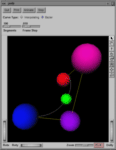

The provided executable executes only on Silicon Graphics workstations equipped with the execution-only-environment (eoe) of Open Inventor (the development environment is not required). For those interested in porting polly to other platforms, the source code is also available in tar archive format; use tar xf polly.tar to unpack the archive. This source code was developed on a Silicon Graphics workstation equipped with the Open Inventor development environment.
We provide no support for polly.
The partly transparent colored spheres mark the control points of the curve. If the curve is an interpolating one, it passes through these points at equally spaced parameter values; otherwise, the spheres mark the Bézier points of the curve. The radio buttons entitled "Curve Type" set the type of the curve.
The color of the spheres indicates the order of the control points: the first control point is blue, and the last is red, while intermediate ones have colors in-between blue and red. The yellow polyline connecting the spheres is the control polygon of the curve; along with the spheres' coloring, it identifies the ordering of the control points.
The spheres can be interactively moved by a click-and-drag interface: but first press the small arrow button on the side of the main window. Also, the viewpoint may be interactively changed: press the small hand button first. These aspects of the user interface are provided by the Open Inventor toolkit, documented on-line: just press the small "?" button.
The animation starts with the particle placed on the first control point. It ends when either the "Stop" button is pressed, or the particle passes the last control point. The speed of the particle's movement is controlled by the "Frame Step" slider, setting the amount by which the simulated time is advanced between successive animation frames.
Permission to use, copy, modify and distribute this software for any purpose is hereby granted without fee, provided that the above copyright notice and this permission notice appear in all copies of this software and that you do not sell the software. Commercial licensing is available by contacting the author.
This software is provided "as is" and without warranty of any kind, express, implied or otherwise, including without limitation, any warranty of merchantability or fitness for a particular purpose.
Author: Apostolos Lerios.